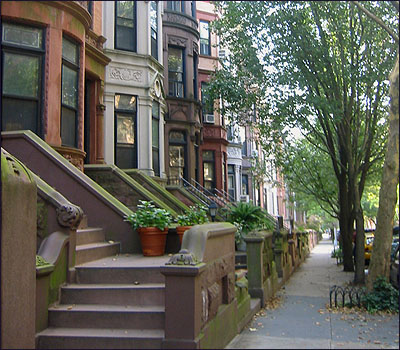
Music

food

Celebrity Gossip

How to...

History

Cars

Animals

Health

Books & Authors

News

Video Games

Gadgets

Fashion


Park Slope
Location:
Neighborhood in northeastern Brooklyn, bounded north by 4th and Flatbush Avenues, to the east by Flatbush Avenue and Prospect Park West, to the south by Prospect Park West and 15th Street and to the west by 4th Avenue.
Description:
Park Slope is known for its vibrant cultural community and is considered one of Brooklyn's major cultural centers. It takes its name from its location on the western slope of neighboring Prospect Park. The neighborhood has many historic buildings, hip restaurants, bars, and retail stores, as well as close access to the Brooklyn Academy of Music, the Brooklyn Botanic Garden, the Brooklyn Museum, and the Central Library (as well as the Park Slope branch) of the Brooklyn Public Library system. Many famous writers, actors, and musicians live in Park Slope
Racial Makeup

Park Slope neighborhoods:



I. Significant Neighborhood Institutions:
1. Prospect Park (with the numerous amenities already listed on your website).
2. Main Branch of Brooklyn Public Library and several smaller branches within the neighborhood
3. Brooklyn Museum - portions of which are newly refurbished
4. Brooklyn Botanic Garden - containing a wonderful cherry tree esplanade, a beautiful and peaceful Japanese garden, and children's garden
5. Saturday Farmers' Market at Grand Army Plaza
6. Music School on Seventh Avenue with regular weekend performances
7. Fifth Avenue (joining Seventh Avenue) containing many new, small, individually owned shops, great restaurants and galleries
8. PuppetWorks, a puppet theater on Sixth Avenue, and a range of other theaters and cultural amenities
9. Park Slope Food Coop - Member owned, run and staffed grocery store with 11,000 members
10. Fifth Avenue Committee - a community development corporation dedicated to preserving affordable housing, employment for low-income and working people and providing many other services to the community in the interests of preserving an economically diverse and affordable neighborhood
11. A special trolley leaving from Grand Army Plaza takes people to the Brooklyn Children's Museum
12. Outdoor flea market every Saturday at P.S. 321
II. Good Transportation Links Many New York City subway lines serve various portions of the neighborhood: the 2, 3, N, R, Q and F lines have stops in the area. There are also a number of buses.
III. Lots of independently owned small businesses including at least three independent bookstores. Some stores, e.g. several ice cream places and a muffin store have quite a bit of seating outside. Because there are lots of places to stop and sit it's a great neighborhood to walk around in.
IV. Lots of Annual Events:
1. The Fifth Avenue Street Fair - every spring
2. The Halloween Parade on Seventh Avenue
3. The St. Patrick's Day Parade
4. The Labor Day West Indian Parade (on Eastern Parkway but ends at Grand Army Plaza)
5. Gay Pride Parade
6. Philharmonic in Prospect Park
7. Summer performances at the Bandshell in Prospect Park
STORY:


Council Member: Bill DeBlasio (District 39)

Click here for information about Bill DeBlasio.
| | ||
| | ||
| |
| | ||
| | ||
| |
New York City Senator:
Senator William J. Larkin Jr.
Click picture for information about William J. Larkin
President of the Borough of Brooklyn :Marty Markowitz
District Manager: Craig R. Hammerman

Click picture for information about Craig R. Hammerman
Assemblyman José R. Peralta

Click on the picture for information Jose Peralta
-- Explain and demonstrate how one of your elected officials supports your community.
Council Member Bill de Blasio has dedicated his life to public service. From working for the parents of Community School District 15, to serving at the U.S. Department of Housing and Urban Development, to managing Hillary Rodham Clinton's successful run for U.S. Senate, he fights the tough fights and wins.
Elected in 1999, de Blasio served as a member of Community School Board 15, where he helped spearhead some of the most comprehensive reforms in the city. District 15 was the first in New York City to cap first grade class size at 20 students and is establishing universal Pre-Kindergarten. De Blasio worked with other Board members to give parents a choice by establishing middle school academies that create smaller, more personal learning environments for students, and was part of an effort to reinvent John Jay High School.
| |
| Throughout his career Bill has worked to build affordable housing and keep neighborhoods affordable for working families. Before he joined the New York City Council in 2001, Bill served in the U.S. Department of Housing and Urban Development (HUD) aiding then Secretary Andrew Cuomo. In the New York City Council Bill has won legislative and land-use victories that have led to the construction of thousands of units of affordable housing throughout Brooklyn. As Borough President Bill's first priority will be to build and preserve affordable housing. Bill's Plan to Make Brooklyn More Affordable for Working Families:
|
Conducted by Transportation Alternatives, a transportation advocacy group, the study reveals:

 What Is Your Life's Blueprint?
What Is Your Life's Blueprint?